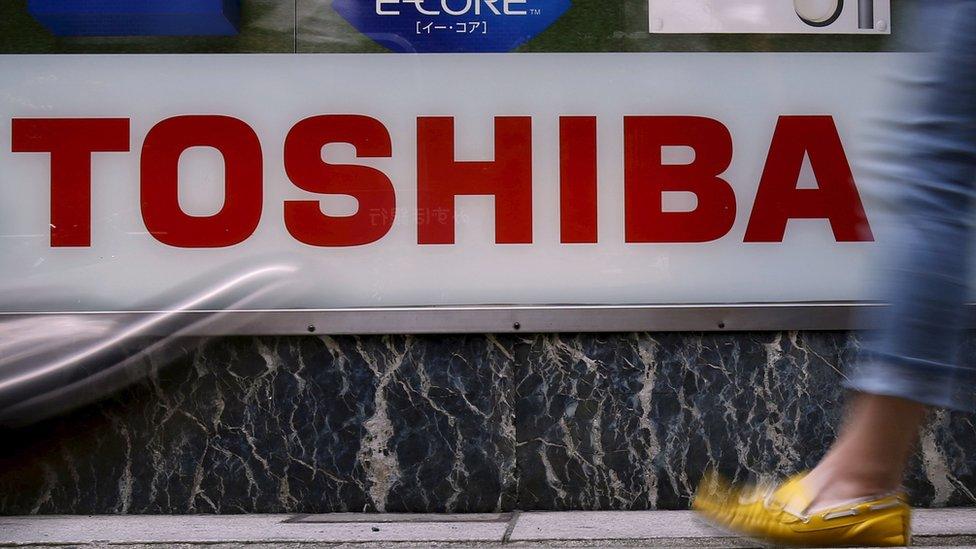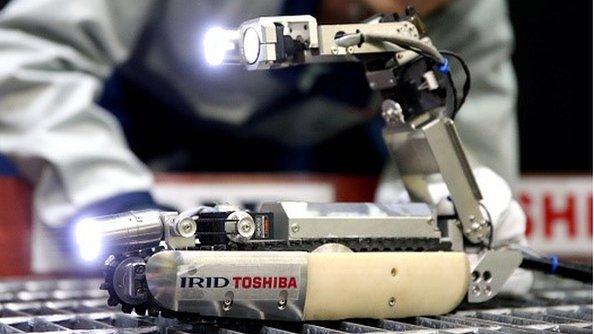Toshiba: What's going wrong?
- Published

Until late December, 2016 had been a decent year for Toshiba.
Then a bombshell. The Japanese industrial giant warned of a big one-off hit at its US nuclear business.
At the time we did not know quite how huge that loss would be. But by February it emerged it would be about $6.3bn (£5.05bn).
Toshiba's chairman resigned, the firm delayed releasing its full financial figures - initially for a month - and then even longer. We're still waiting.
To plug the gap, Toshiba is set to sell a majority stake in its NAND flash-memory business to get it through its ongoing financial turbulence.
And its US nuclear business Westinghouse has filed for Chapter 11 bankruptcy - which temporarily shelters struggling firms as they try to restructure their affairs and outstanding debts.
All this comes as it struggles to turn the corner after a profit-inflating scandal.
What has gone wrong?
Most people still recognise the name Toshiba for its electrical products but that is no longer at the heart of its business. It no longer makes televisions for export, for example, and its white goods business is losing money.
Today Toshiba is a very diverse conglomerate, and these latest problems stem from its nuclear services business which brings in about a third of its revenue.
Toshiba had initially alerted investors in December 2016 to the fact that it faced a heavy one-off loss linked to a deal done by its US nuclear subsidiary, Westinghouse Electric.
Westinghouse bought a nuclear construction and services business from Chicago Bridge & Iron (CB&I) in 2015. But assets that it took on are likely to be worth less than initially thought, and there is also a dispute about payments that are due.
Toshiba has also reported "inefficiencies" in the labour force at CB&I, along with other factors driving up costs.
So what now?
Toshiba hopes its saviour will be another major part of its business, the unit that makes memory chips for smartphones and computers, which has been valued at between $9bn and $13bn.
It is the second largest chip maker in the world, behind Samsung.
On 27 January, Toshiba announced it would split off this part of the business from the rest of the company - with plans to sell a slice of it to raise much-needed funds to help offset the losses in the nuclear division.
Initially the idea was to sell a small chunk of this business, about 20%, but now Toshiba finds itself in such dire straits that it may have to shed a larger proportion of this NAND memory unit.
A 20% sale would raise more than $2bn, which may not be sufficient given the current difficulties. Also would-be buyers are likely to try and negotiate a knockdown price.
The Development Bank of Japan has been talked about as one potential investor. Industry rivals including Canon and Western Digital are also thought to be eyeing a bid, and another potential buyer could be South Korea firm, SK Hynix.
It wouldn't be the first time in recent memory Toshiba has sold off profitable ventures. Its medical devices business (making things like MRI, ultrasound and X-ray equipment) was snapped up by Canon in 2016 for $5.9bn.
What does this mean for Toshiba's reputation?
It seems somebody, somewhere got the numbers wrong or did not anticipate the scale of problems in the nuclear business, and that reflects badly on the firm's management.
Also, the fiasco of its earnings announcement will not have helped. Toshiba has not release its figures as scheduled in February, then missed anther self-imposed deadline a month later.
It did however release earnings guidance and unaudited numbers, with the promise of audited figures in a month.
In addition, Toshiba is still struggling to recover after it emerged in 2015 that profits had been overstated for seven years, prompting the chief executive to resign.
What are the prospects for Toshiba's nuclear business?
Toshiba's nuclear business has not made a profit since 2013.
And while the firm has said the huge writedown will be a one-off, nuclear services globally are struggling.
Since the Fukushima disaster in 2011, nuclear energy has been a much harder sell. Some governments have opted to scale back how much they planned to rely on nuclear as an electricity source, or - as in the case of Taiwan - turn away from nuclear energy altogether to focus on renewables.
Big nuclear projects around the world have faced heavy delays, partly caused by a lack of skilled workers needed to meet regulatory standards.
For example in the US, Westinghouse (which Toshiba bought in 2006) is working on two new generation nuclear reactors in Georgia and South Carolina which are running late and over budget.
By filing for Chapter 11 bankruptcy, Westinghouse will be able to renegotiate or break its construction contracts - although the businesses that own the projects it is working on would likely seek damages.
Shares are down by more than 50% since mid-December 2016 - but why does a falling share price matter?
Shares have fallen for a reason: investors selling up because of the unease they feel about the position the company is in. That uncertainty saw ratings agencies cut their ratings on Toshiba's credit, making it more expensive for the firm to borrow money.
A lower share price also reduces the amount of new funds that can be raised by selling shares. So if it needs to raise funds, that means going to the banks for support or, as we are seeing, selling off parts of the business.
And clearly for investors who've held on to Toshiba shares, they are now worth markedly less than they were before Christmas.
Longer term though, Toshiba shares had been doing very well in 2016. Until 26 December they were the second biggest gainer on the Nikkei 225 index for the year, adding more than 70%. The sharp losses in late December meant annual gains were pared to about 5%.
- Published28 December 2016

- Published6 May 2016
